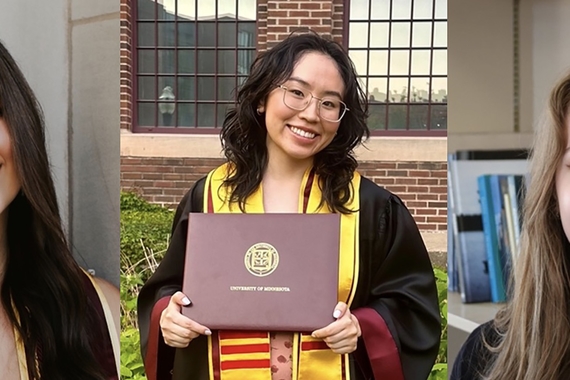Unite to Write
High school writing center coaches Steven Wang (left) and Emil Liden presented their poster on supporting English language learners. At the summit, poster sessions provided an opportunity for coaches to share their research on writing center theory and practice. Photo courtesy of Jasmine Kar Tang.
Over the past several decades, writing centers have become ubiquitous in higher education. Across the nation, universities create spaces for peers to push through writer’s block and learn strategies for revising and editing. Looking to the success of these college programs, Kirsten Jamsen, director of the University of Minnesota’s Center for Writing, was eager to see writing centers implemented at all educational levels, not just the collegiate level.
Humble Beginnings
In 2007, after five years at UMN, Jamsen was contacted by Maggie Shea from Minnetonka High School, as Minnetonka had just been given the funds to start its own writing center. This was the beginning of a long partnership between Jamsen and Shea, fueled by their passion for high school writing centers in Minnesota.
As the Minnetonka Writing Center grew, more districts became interested and reached out to Shea or Jamsen to learn more. At this time, Shea had begun sitting in on “Writing Center Professionals of Minnesota” meetings, a grassroots group of collegiate writing center directors. As more schools asked her for help, Shea was inspired to make her own collective.
Jamsen was thrilled to help. “[Here at the U] we have an arm of our center, the Minnesota Writing Project, that's all about supporting the work of K-12 teachers, and a second arm for Student Writing Support that's all about doing one-on-one consultation pedagogy. I thought, ‘Gosh it would be a wonderful merger of these two parts of our center to start working with high schools,’” she says.
On September 13, 2010, teachers from across the state met for the first time to discuss writing centers in schools. The group was quickly named the E-12 Writing Centers Collective and was open to anyone thinking about writing centers in preschool, elementary, or secondary schools. It became a place to ask questions, encourage a sense of community, and dream together. Now with a 60+ person listserv and a Google Team Drive, teachers have formed a network to inspire and aid each other.
The Center for Writing is eager to help in any way they can. “We really want to help them build up their own writing centers because we believe one of the powerful things about writing centers is that, yes, it helps writers who come to use this resource, but there’s such a critical learning and leadership opportunity for students who work as writing consultants too,” explains Jamsen.
English and French teacher Anthony Letourneau at Hastings High School agrees with Jamsen and describes the mission of Hastings’ writing center: “While thinking about our writing center and how to share the purpose with student writers and coaches, we developed the motto: All Ages. All Pages. All Stages... [We] hope that student writers feel the writing center is a space of their own where any student of any grade (all ages) can come with any writing, personal or academic (all pages), at any point in the process (all stages),” he explains.
Mutual Learning
When Burnsville High School teacher Marie Hansen began a writing center out of her classroom, she reached out to Jamsen, asking if her students could come to the University of Minnesota to see what a full writing center looks like. The U’s college writing consultants met one-on-one with the high school writing coaches, giving feedback on their writing and a chance to see how a developed writing center functions. This sort of “field trip” became fundamental for many new Minnesotan centers.
These trips are mutually important for the college. Jamsen explains, “We see it as incredibly valuable for our consultants to also get out of their comfort zone a little in working with a high school student and be reminded of where high school students are coming from. How can we think about the students we help who are transitioning from high school to college? This idea of mutual learning is so important.”
Jasmine Tang, co-director of Minnesota’s Center for Writing, stresses the importance of the University modeling a healthy community to the new writing centers across the state. “Part of this work is really disrupting the hierarchy that accompanies educational spaces. For us, it's really important that as consultants, we are not experts. We want to think of the writer as the expert. For me, these ‘field trips’ are very reinvigorating; it's great to have young people in the space. They bring another kind of energy. It helps us rethink our own practice,” she states.
Both Tang and Jamsen are thrilled with the advancement of the E-12 Writing Centers Collective over the past decade. All are welcome at the Collective’s meetings, and there are no designated officers of the group. It is simply a place for teachers to encourage and learn from each other.
The Collective Today
Last year, the E-12 Writing Centers Collective hosted their first ever Secondary Writing Centers Summit at Shattuck-St. Mary’s School, a boarding school in Faribault, Minnesota. The dream was to create “a space for writing center coaches from different high schools to present their research in front of a group of other writing center coaches from across the state,” explains Tang. The student coaches could talk about their own experiences, not just hear from teachers. A second wildly successful Summit occurred again on April 5 of this year.
Tang, Jamsen, and all the writing center teachers are proud of how their little collective grew. They hope that the relationships between schools will only continue to strengthen.
The University of Minnesota’s Center for Writing will continue to give its time and labor to aid the Collective, but it wants to remain behind the scenes and encourage the Collective’s network to be self-sufficient.
Jamsen smiles, “There is a beautiful blossoming of writing centers. The real hope now is that they will sustain.”
This story was written by an undergraduate student in CLA.



